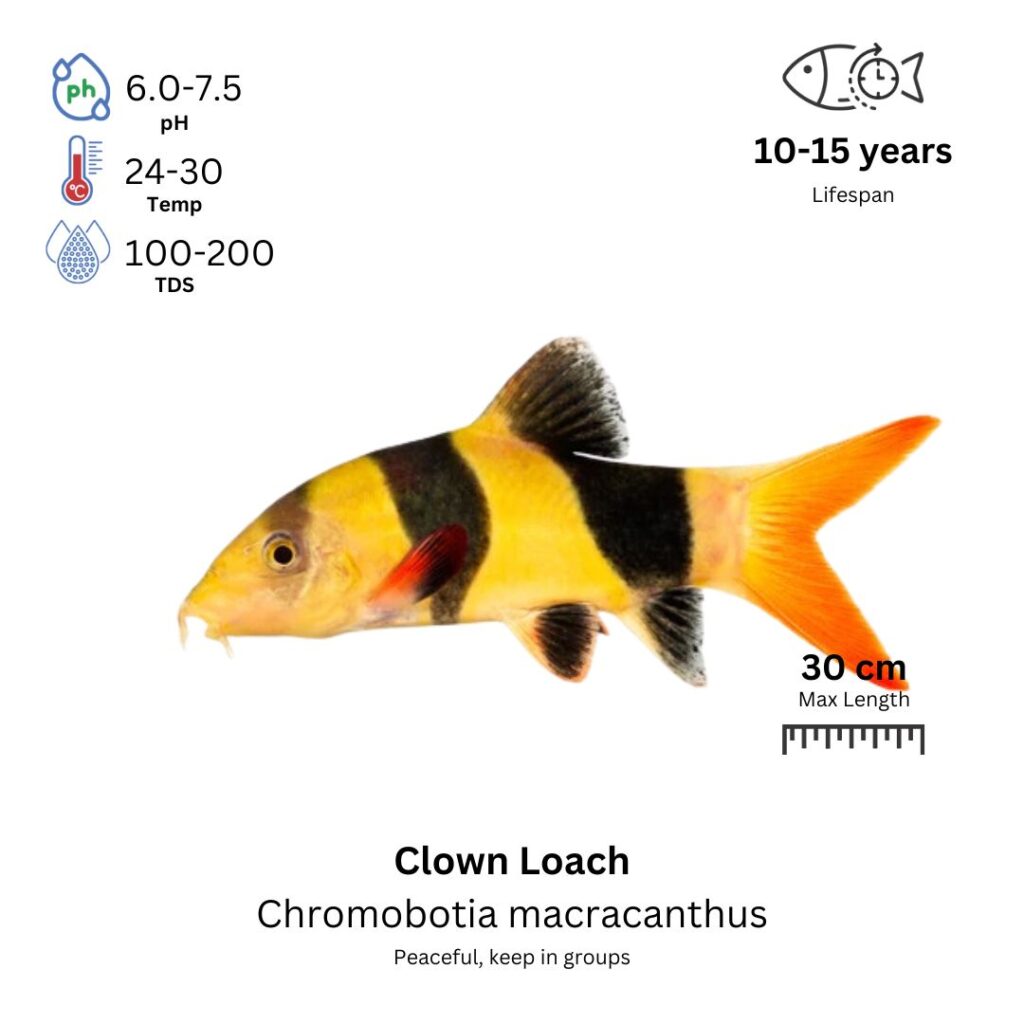Clown Loach
Chromobotia macracanthus

Description
The Clown Loach is a colorful and lively fish, easily recognizable by its bold orange body with black horizontal stripes and its slightly elongated, clownish appearance. As a bottom-dweller, it prefers to hide in caves or crevices but is quite active, especially when kept in schools. These fish are playful and curious, often interacting with each other and their environment. They are known to grow fairly large and live long lives in proper care, making them a favorite for experienced aquarists.
Habitat Origin
Native to Southeast Asia, particularly the rivers and streams of Indonesia, Borneo, and Sumatra.
Aquarium
Ideal Number in Aquarium: At least 3-4 individuals to ensure schooling behavior. They are social and thrive when kept in groups.
Favorite Food

Clown Loaches are omnivorous and will eat a variety of foods, including high-quality pellets, flakes, live food (like worms), and frozen foods. They also enjoy occasional vegetable matter, such as zucchini and spinach. They are great scavengers and will clean up leftover food from the substrate.
Behavior:
Clown Loaches are peaceful and active, particularly during the evening and night when they become more social and playful. They do well in a community tank and are especially known for their antics when kept in groups. They are quite peaceful and generally get along with other fish, even those of a different species. However, due to their potential size and activity level, they should not be kept with small or delicate fish that could be overwhelmed.
Special Care:
Clown Loaches require a well-maintained tank with plenty of hiding spots, like caves, driftwood, and rocks. They are sensitive to poor water conditions, so regular water changes and proper filtration are essential. The tank should have a peaceful environment with gentle water flow to mimic their natural habitat.
Compatibility with Other Fish:
Yes, they are compatible with a wide variety of peaceful community fish, including other tetras, barbs, and small to medium-sized cichlids. Avoid aggressive or territorial species that might harass them. They do best in groups of their own kind and enjoy interacting with other peaceful fish.
Breeding Tank Setup
A dedicated breeding tank is essential for Clown Loaches due to their sensitivity and large size. A 75-gallon (280-liter) tank or larger provides enough space for their natural behavior and ensures water quality remains stable. These fish prefer slightly acidic to neutral water, with a pH of 6.5–7.5, temperature between 26°C and 30°C, and water hardness of 4–10 dGH. Use a high-quality canister or sponge filter to maintain clean, oxygenated water without producing strong currents. The tank should have a soft substrate like sand, hiding spots made from driftwood or caves, and low to moderate lighting on a 12-hour day/night cycle to mimic their nocturnal nature and reduce stress.
Conditioning the Breeders
Clown Loaches are omnivorous and should be conditioned with a varied, nutrient-rich diet. Feed them a combination of sinking pellets designed for bottom dwellers, live or frozen foods like bloodworms and brine shrimp, and blanched vegetables such as zucchini, peas, or spinach. This well-rounded diet supports their health and reproductive readiness. Weekly water changes of 20–30% help maintain pristine conditions. Gradually increasing water temperature and simulating “rainy season” conditions with soft, slightly cooler water during changes can help trigger spawning behavior.
Spawning Process
In captivity, Clown Loaches may spawn in the early morning after environmental cues mimic rainy-season conditions. They are egg scatterers; females release eggs near the substrate or among decor, and males fertilize them externally. A single female can produce 500–1,000 eggs during a spawn. After spawning, promptly remove the adults from the breeding tank to prevent them from consuming the eggs. Leaving the eggs undisturbed gives them the best chance of developing into fry.
Fry Development
Clown Loach eggs hatch within 24–36 hours, depending on temperature. The newly hatched fry are extremely small and vulnerable, typically resting near the substrate. Feed them infusoria or liquid fry food initially. As they grow, introduce microworms, baby brine shrimp, and finely crushed flakes. Keep the tank stable with small, frequent water changes (10–20% daily or every other day) and avoid overfeeding to prevent water pollution. Gentle filtration and a biofilm-rich environment will support healthy fry development.
Breeding Tips
Clown Loaches reach breeding maturity around 3–4 years of age, though successful breeding often occurs with older, well-conditioned individuals. Females are generally rounder and larger, especially when gravid, while males are slimmer. Due to their subtle differences, sexing is best done through observing spawning behavior. Avoid stressful conditions such as sudden water changes, poor water quality, or overcrowding. Consistent, gentle care and stable water parameters are essential for a successful Clown Loach breeding project.
